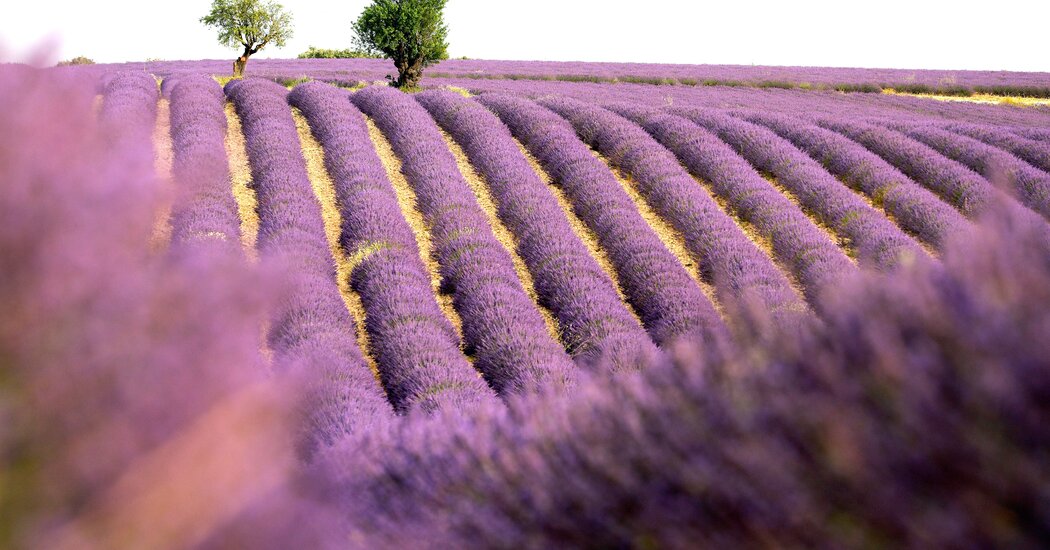A year ago, Jonathan Grahm, a chocolatier, visited Paris and noticed the ubiquity of lavender in French soaps and lotions. He wanted to add a floral-leaning chocolate to his lineup at Compartés, a confectionery shop in Los Angeles established in 1950, and figured that lavender was his way in.
Mr. Grahm harnessed his inspiration into a lavender white chocolate bar using flower buds from farmers’ markets in California. It was a tricky experiment, but now the pastel-purple bar is one of the company’s most popular, with more than 10,000 sold in the last year. For Mother’s Day, Mr. Grahm has doubled down, creating a floral-themed holiday box featuring a chocolate truffle made with grapefruit and lavender.
“Lavender is a really beautiful scent,” he said. “I really wanted to translate that to a chocolate.”
In the fall, consumers clamor for anything with the warm flavors of pumpkin spice. But as tulips and daffodils start to blossom, lavender, a member of the mint family, has become the taste of the season — even though the plant doesn’t bloom until the summer.
Starbucks, Bluestone Lane, About Coffee and other craft coffee shops have introduced exceedingly popular lattes and matcha drinks featuring the flower. Bars in New York and Los Angeles are serving cocktails infused or sprinkled with lavender buds. Companies like Jeni’s and Salt and Straw have produced ice cream flavors with the herb.
The Wakehouse, a cocktail bar in Reedley, Calif., recently introduced a specialty cocktail featuring lavender simple syrup, lemon juice, butterfly pea flower-infused gin, Licor 43 and dried lavender as a garnish, said Justin Simmons, the general manager there. (One of the bartenders named the drink “lavender haze” after a Taylor Swift song of the same name.)
Lavender’s dominance of springtime menus first sprouted in 2020, said Jenny Zegler, a director of food and drink data at Mintel, a market intelligence and research agency. This interest has been fueled by several factors: Consumers are more interested in natural — and not overly sweet — floral flavors. Its vibrant purple color looks great on social media. And the Taylor Swift connection doesn’t hurt, either.
“This is the perfect storm for lavender,” Ms. Zegler said.
Food and drinks with lavender can taste like perfume if the flavor is too overpowering. But farmers, chefs and baristas have found that subtlety comes down to the variety of lavender used.
Chanan Rozenbaum, an owner of the farm Lavender by the Bay in Calverton and East Marion, N.Y., said he cultivates an English variety of lavender for use in cooking because it’s not as pungent as the French varietal, which is better suited to crafting and garnishing. Dawn McCormick, an owner at McCormick Farmz in Wolverine, Mich., sells culinary products like balsamic vinegar and olive oil made with this variety. She saw a 20 percent increase in orders this year — about $50,000 more in sales — for items she infuses with the flower. Restaurants nearby use the vinegar and oil in dressings, sauces or marinades.
“It’s a happy little herb that you use like the rest,” Ms. McCormick said.
Jeremy Fox, an early adopter of lavender in culinary contexts, has used lavender in place of rosemary since the opening of Ubuntu in Napa, Calif., in 2007. As the executive chef there, he served Spanish Marcona almonds seasoned with olive oil, sugar, salt and dried lavender from the restaurant’s farm. About a decade later, he put those same almonds on the menu of his restaurant Birdie G’s in Santa Monica.
“I thought there were similarities between rosemary and the lavender, both in the leaves and the purple flowers,” Mr. Fox said.
Wynne Wright, a retired professor of agriculture at Michigan State University and the coordinator of the Great Lakes Lavender Growers association, said she has seen the number of lavender farms in the state “more than triple” in the last decade to meet the demand. When Ms. Wright opened her own lavender farm, Sixteen Sprigs, in Lansing, Mich., in 2014, she began incorporating the flower in chocolate, maple syrup, cake mixes and cookies. This year, she will introduce a lavender-honey ice cream.
She calls lavender “the Swiss Army knife of the herb world.”
“How many things can you use to eat and take a bath with?” she said.
Follow New York Times Cooking on Instagram, Facebook, YouTube, TikTok and Pinterest. Get regular updates from New York Times Cooking, with recipe suggestions, cooking tips and shopping advice.







